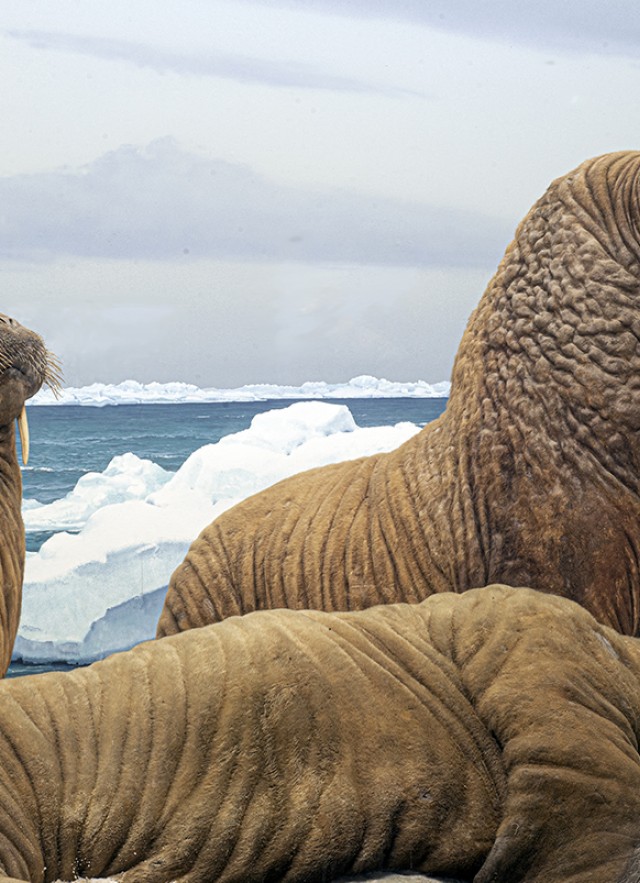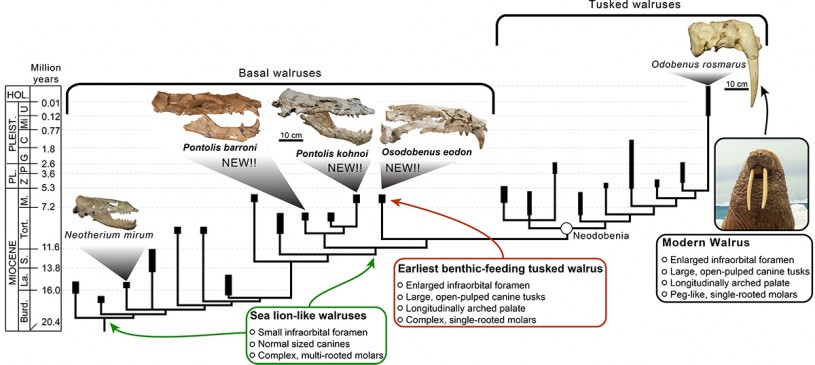November 16, 2020 (Los Angeles, CA)— Natural History Museums of Los Angeles County (NHMLAC) scientist Jorge Velez-Juarbe, Associate Curator of Marine Mammals, and CSU Fullerton’s James F. Parham, a research associate in Vertebrate Paleontology at NHMLAC, along with colleague Jacob N. Biewer of CSU Fullerton have uncovered new evidence from 5–10 million-year-old specimens about the evolution of modern walruses, describing three extinct species in an article published on November 16, 2020 in the Journal of Vertebrate Paleontology.
Walruses can be found throughout the Arctic and subarctic regions of the world and are known for their large tusks and bottom-feeding habits. The fossil record of walruses spans the last 17 million years, with specimens found across the North Pacific Basin, from Japan to Baja California Sur. The three new species of extinct walruses were found by examining twelve specimens collected from Los Angeles, Orange, and Santa Cruz counties in California. In addition to specimens of the previously described Imagotaria downsi and Pontolis magnus found elsewhere in California and Oregon, all of the specimens of the newly discovered species were found in Orange County (Pontolis barroni, Pontolis kohnoi, and Osodobenus eodon).
The new species lived between 5.8 to 8.7 million years ago during a time when the ocean was much farther inland in Orange County and other parts of California. These walruses lived alongside other pinnipeds, including some extinct relatives of the Northern Fur Seal and California Sea Lion, large and small species of baleen whales, dolphins, sperm whales, and giant kelp-eating seacows.
Analysis of these fossil walrus specimens showed that throughout most of their history, walruses had variable dental anatomy. One of the new species found in Orange County, Osodobenus eodon, is the most primitive walrus with tusks and specialized for bottom-feeding, with the other two newly described species being more similar in appearance to sea lions. It is only until around 5 million years ago (at the end of the Miocene) that a more modern-looking, tusked walrus appears.
“The discovery of these new fossils, some representing species that lived alongside each other, shows us that the evolutionary history of walruses is far from being completely understood,” says NHMLAC’s Dr. Jorge Velez-Juarbe. “This is the latest example of how museum collections have an important role in documenting ancient marine biodiversity across Southern California and the North Pacific.”
Most of the specimens described in this work, including the three newly described species, are from Natural History Museums of Los Angeles County’s (NHMLAC) Vertebrate Paleontology collections, which have one of the largest collections of fossil pinnipeds (which includes seals, fur seals, and sea lions) in North America.
“These findings perfectly illustrate just how important Orange County is for fossil walruses,” says co-author Jacob N. Biewer. “The large number of specimens at NHMLAC provide much needed information on past diversity as well as the origin of tusks.”
Reference: Jacob N. Biewer, Jorge Velez-Juarbe & James F. Parham (2020) Insights on the dental evolution of walruses based on new fossil specimens from California, Journal of Vertebrate Paleontology, DOI: 10.1080/02724634.2020.1833896
The authors of this article are affiliated with California State University, Fullerton; the Natural History Museum of Los Angeles County; and the Smithsonian National Museum of Natural History.
For a copy of the article published in the Journal of Vertebrate Paleontology and imagery, please contact Sally Marquez, smarquez@nhm.org.
About the Natural History Museums of Los Angeles County
The Natural History Museums of Los Angeles County (NHMLAC) include the Natural History Museum in Exposition Park, La Brea Tar Pits in Hancock Park, and the William S. Hart Museum in Newhall. They operate under the collective vision to inspire wonder, discovery, and responsibility for our natural and cultural worlds. The museums hold one of the world’s most extensive and valuable collections of natural and cultural history—more than 35 million objects. Using these collections for groundbreaking scientific and historical research, the museums also incorporate them into on- and offsite nature and culture exploration in L.A. neighborhoods, and a slate of community science programs—creating indoor-outdoor visitor experiences that explore the past, present, and future. Visit NHMLAC.ORG for adventure, education, and entertainment opportunities

